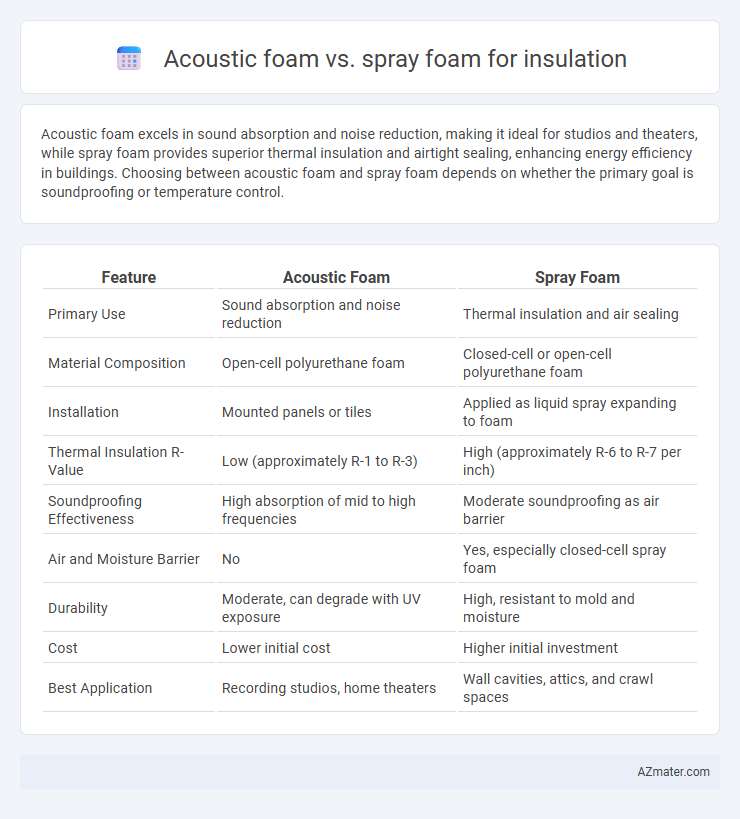Acoustic foam excels in sound absorption and noise reduction, making it ideal for studios and theaters, while spray foam provides superior thermal insulation and airtight sealing, enhancing energy efficiency in buildings. Choosing between acoustic foam and spray foam depends on whether the primary goal is soundproofing or temperature control.
Table of Comparison
| Feature | Acoustic Foam | Spray Foam |
|---|---|---|
| Primary Use | Sound absorption and noise reduction | Thermal insulation and air sealing |
| Material Composition | Open-cell polyurethane foam | Closed-cell or open-cell polyurethane foam |
| Installation | Mounted panels or tiles | Applied as liquid spray expanding to foam |
| Thermal Insulation R-Value | Low (approximately R-1 to R-3) | High (approximately R-6 to R-7 per inch) |
| Soundproofing Effectiveness | High absorption of mid to high frequencies | Moderate soundproofing as air barrier |
| Air and Moisture Barrier | No | Yes, especially closed-cell spray foam |
| Durability | Moderate, can degrade with UV exposure | High, resistant to mold and moisture |
| Cost | Lower initial cost | Higher initial investment |
| Best Application | Recording studios, home theaters | Wall cavities, attics, and crawl spaces |
Understanding the Basics: Acoustic Foam vs Spray Foam
Acoustic foam is designed primarily to absorb sound waves, reducing echo and noise within indoor environments by using open-cell polyurethane materials that trap and dissipate sound energy. Spray foam insulation, typically made from polyurethane or similar substances, serves to seal and insulate spaces, creating an airtight barrier that prevents heat transfer and improves energy efficiency. While acoustic foam targets soundproofing applications, spray foam focuses on thermal insulation and air sealing, making each suitable for different aspects of building performance.
Composition and Material Differences
Acoustic foam is typically made from polyurethane or melamine foam designed to absorb sound waves, reducing echo and reverberation in a room. Spray foam insulation consists of polyurethane or other chemicals that expand upon application, creating an air-tight seal for thermal insulation and moisture resistance. The key material difference lies in acoustic foam's porous structure for sound absorption, while spray foam's dense, expanding composition provides superior thermal resistance and air sealing.
Primary Functions: Soundproofing vs Thermal Insulation
Acoustic foam primarily targets soundproofing by absorbing sound waves and reducing echo, making it ideal for recording studios and noisy environments. Spray foam excels in thermal insulation, forming an airtight barrier that minimizes heat transfer and energy loss in buildings. While acoustic foam enhances auditory comfort, spray foam improves energy efficiency and temperature regulation.
Installation Process Comparison
Acoustic foam typically features a straightforward installation involving adhesive application or mounting with hooks, allowing for easy repositioning and minimal preparation. Spray foam requires professional application, using specialized equipment to expand and cure within cavities, ensuring airtight insulation but demanding safety precautions and curing time. The installation of spray foam offers superior sealing capabilities in irregular spaces, while acoustic foam excels in quick, surface-level sound absorption tasks.
Performance in Noise Reduction
Acoustic foam excels in noise reduction by absorbing mid to high-frequency sound waves, making it ideal for controlling echoes and reverberations in indoor environments. Spray foam insulation provides better soundproofing against a wider range of frequencies due to its dense, airtight structure that minimizes sound transmission through walls and ceilings. Both materials contribute to improved acoustic performance, but spray foam offers superior noise-blocking capabilities in addition to thermal insulation.
Effectiveness in Thermal Insulation
Acoustic foam primarily targets sound absorption with limited thermal insulation properties, making it less effective for temperature regulation. Spray foam insulation provides superior thermal resistance due to its ability to expand and seal gaps, creating an airtight barrier that minimizes heat transfer. The R-value of spray foam typically ranges from 6 to 7 per inch, significantly outperforming acoustic foam's low thermal resistance.
Durability and Longevity
Acoustic foam offers moderate durability primarily designed for sound absorption, but it can degrade faster in high humidity or physical impact environments. Spray foam insulation provides superior longevity and structural durability, as it creates an airtight seal resistant to moisture, pests, and temperature fluctuations. The closed-cell spray foam variant typically lasts over 30 years, outperforming most acoustic foam products in long-term insulation effectiveness.
Cost Analysis: Initial Investment and Maintenance
Acoustic foam typically requires a higher initial investment due to specialized materials aimed at soundproofing, whereas spray foam insulation offers a more cost-effective upfront solution for thermal insulation. Maintenance costs for acoustic foam can increase over time because of its susceptibility to dust and degradation, while spray foam generally demands minimal upkeep once applied. Evaluating long-term expenses, spray foam insulation often proves more economical, balancing initial expenditure with durability and efficiency.
Ideal Applications for Each Insulation Type
Acoustic foam is ideal for soundproofing in studios, home theaters, and recording rooms due to its ability to absorb mid to high-frequency noise and reduce echo. Spray foam excels in thermal insulation for walls, attics, and crawl spaces by creating an airtight seal that prevents heat loss and moisture infiltration. Choosing the right insulation depends on whether sound absorption or energy efficiency is prioritized in the space.
Choosing the Right Foam: Key Considerations
Choosing the right foam for insulation depends on specific needs such as soundproofing versus thermal insulation. Acoustic foam excels in absorbing sound waves and reducing noise levels, making it ideal for studios and theaters, while spray foam provides superior thermal insulation by expanding to fill gaps and preventing air leaks. Key considerations include the desired R-value, installation environment, and whether the primary goal is noise reduction or energy efficiency.

Infographic: Acoustic foam vs Spray foam for Insulation
 azmater.com
azmater.com